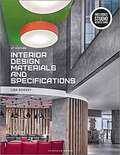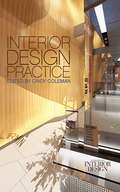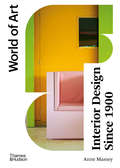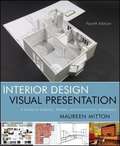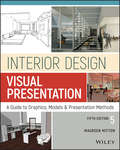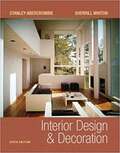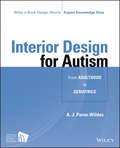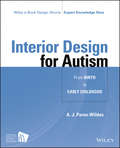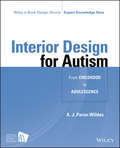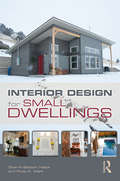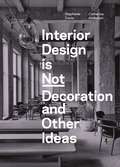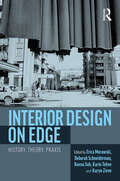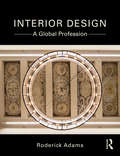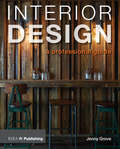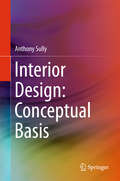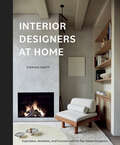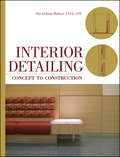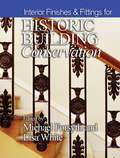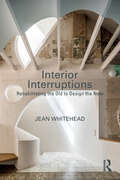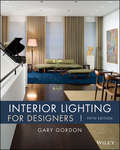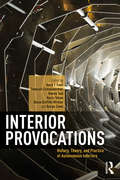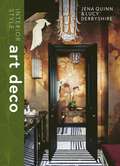- Table View
- List View
Interior Design Materials and Specifications
by Lisa GodseyThis complete guide to the selection of materials for interiors has been updated to reflect the most recent materials on the market and contemporary awareness on industry movements like sustainability. Written from the viewpoint of the working designer, Interior Design Materials and Specifications, 4th Edition, describes each material’s characteristics and teaches students how to evaluate, select, and specify materials, taking into account factors including code compliance, building standards, sustainability guidelines, human needs, and bidding processes. Students will learn how to communicate with suppliers and vendors to achieve the results they envision and how to avoid some of the pitfalls common to material selection and specification. <p><p> New to this Edition:<p> -Removed laminated materials chapter and dispersing information into related materials chapters<p> -Inclusion of a Smart Materials chapter and sustainability information throughout<p> -Updated all case studies throughout text<p>
Interior Design Practice (Interior Design Ser.)
by Cindy ColemanInterior Design magazine has assembled some of the most notable voices in the interior design world today under editor-in-chief Cindy Coleman to define contemporary interior design and its practice. Interior Design Practice provides aspiring and practicing professionals a perspective that is as broad as it is deep, encompassing design theory and education, global professional practice, and the experiences of design firms large and small. An overview is provided of the development and growth of the profession, along with an in-depth assessment of the legal and regulatory environment. An extensive section is offered on the work process, ranging from pre-design, programming, and design development to contract administration. Finally, a section on management provides a thorough exploration of issues in marketing, financial management, project management, and managing client relationships. Both comprehensive and timely,Interior Design Practice describes the changes currently occurring in the design profession and industry and suggests new, unique ways of thinking and working that will serve as a catalyst for designers who seek excellence in their profession. List of Contributors, their company, and their location: - Edward Friedrichs, (former President, Gensler) San Francisco - Derrel Parker, Parker Scaggiari,Las Vegas - Cindy Coleman, Chicago - Beth Harmon Vaughan, Gensler, Phoenix - Barry LePatner, LePatner & Associates, LLP, New York - Eva Maddox, Perkins + Will, Chicago - Sharon Turner, Swanke Hayden Connell Architects, London - Pamela Anderson Brule, Pamela Anderson Brule Architects, San Jose - Orlando Diaz-Azcuy, San Francisco - Stuart Cohen, Cohen/Hacker Architects, Chicago - David Boeman, Powell + Kleinshmidt, Chicago - Greg Switzer, Robert Sutter, Switzer Architects, New York - Lisabeth Quebe, (Former VP, Perkins + Will) Soldiers Grove, WI - Gary Wheeler, Wheeler Kanik, Richmond, UK - Kathy Rogers, Jacobs Facilities, Arlington, VA
Interior Design Since 1900: Fourth Edition (World of Art #0)
by Anne MasseyNewly updated and overflowing with color, this well-established history of interior design describes and illustrates each movement and change in taste throughout the twentieth century. Interior design experienced an extraordinary amount of changes in taste and style during the twentieth century. From William Morris and the Arts and Crafts movement to expressionism, postmodernism, and green design, Interior Design Since 1900 charts them all. Featuring more than two hundred color illustrations of interiors from around the world, this book reveals the fundamental changes in style that occurred throughout the century. The 1900s saw the emergence of professional designers and a growing appetite to redesign homes to keep up with popular fashion. In recent decades, the focus has shifted toward public spaces and sustainable design. In this survey, Anne Massey explores the social, political, economic, and cultural contexts of these developments. This book has been a classic introduction to interior design for almost thirty years. The new, fourth edition is brought up-to-date with a chapter on transnational design, encompassing mid-century modernist work in Singapore and Sri Lanka, as well as more recent interior spaces, including luxury hotels in Dubai and a contemporary art museum in Cape Town. Through this book, Massey shows how a shared language of design and cutting-edge technology are reshaping interiors around the globe.
Interior Design Visual Presentation
by Maureen MittonA practical, comprehensive guide to developing effective design communication skillsFrom doing a quick sketch to producing a fully rendered model, the ability to create visual representations of designs is a critical skill for every designer. Interior Design Visual Presentation, Fourth Edition offers thorough coverage of interior design communication used throughout the design process, complete with a broad range of real-world examples.This fully updated handbook presents the full range of styles and techniques used for interior design visual communication, from hand drawing to 3D computer modeling. Its accessible, how-to approach guides you through a variety of methods for executing creative and successful design graphics, models, and presentations. Recognizing the ongoing proliferation of digital tools for visual representation, this edition provides the latest information on 2D design presentation software, such as Photoshop, SketchUp, Revit, and AutoCAD. Dozens of high-quality, full-color illustrations highlight step-by-step instructions detailing techniques and approaches throughout the book.Standout features of this new edition include: Discrete chapters devoted to manual, freehand, and digital drawing Numerous examples of quick-sketching techniques as well as computer-generated, 3D representations using Google SketchUp and other software Updated coverage of graphics, composition, and organization of presentations A range of examples from small residential student projects to huge public interior spaces designed by leading professionals New coverage of rendering In-depth coverage of a wide range of material sample presentation boards From traditional to cutting-edge techniques, Interior Design Visual Presentation, Fourth Edition gives students and professionals alike the tools to give visual life to their design vision.
Interior Design Visual Presentation: A Guide to Graphics, Models and Presentation Methods
by Maureen MittonA newly updated and comprehensive guide to all aspects of visual design From doing a quick sketch to producing a fully rendered model, the ability to create visual representations of designs is a critical skill for every designer. Interior Design Visual Presentation, Fifth Edition offers thorough coverage of interior design communication used throughout the design process, complete with a broad range of real-world examples. This fully updated handbook presents a full range of styles and techniques used for interior design visual communication, from hand drawing to 3D computer modeling. Its accessible, how-to approach guides you through a variety of methods for executing creative and successful design graphics, models, and presentations. Recognizing the ongoing proliferation of digital tools for visual representation, this edition provides the latest information on software used in presentation such as Photoshop, and SketchUp, and covers the integration of Revit, and AutoCAD generated content into design presentations. • Covers all aspects of visual design and presentation for interior designers • Includes color illustrations that feature a wide range of project types including residential, healthcare and public projects, designed to highlight step-by-step instructions • Provides a discussion of incorporation of 3D digital models into presentations including use in virtual reality, and expanded information on scale models including a discussion of 3D printing • Includes a companion website for instructors, featuring PowerPoint lecture slides and an instructor's manual From traditional to cutting-edge techniques, Interior Design Visual Presentation, Fifth Edition gives students and professionals alike the tools to give life to their design vision.
Interior Design and Decoration
by Stanley Abercrombie Sherrill WhitonAddressing interior design and decoration from the ancients to the moderns, this text describes the dominant influences of fashion design and focuses on the close relationship between interior design and the architecture of our times. <p><p> With the Sixth Edition of Interior Design and Decoration, Stanley Abercrombie continues the revival of this time-tested and well-respected text—first published in 1937—to make it meet the needs of today’s teachers and students. In his second revision of Sherrill Whiton’s classic text, Abercrombie presents the full history of interior design—during all periods and throughout all regions—in a manner that facilitates easy comparisons among different times, places, and styles.
Interior Design for Autism from Adulthood to Geriatrics (Wiley E-book Design Shorts)
by A. J. Paron-WildesWhen designing spaces for individuals with Autism, there are specific design strategies that can be employed to create optimal spaces that can have a positive impact on special learning and sensory needs. Interior Design for Austism from Adulthood to Geriatrics gives designers the exact information they need to implement these design strategies in their own projects. Projects covered relate specifically to the age ranges from adulthood through geriatric age, including workplaces, clinical settings, and nursing homes. The main neurofunctions of Autism are covered along with specific design techniques that can be used to address each one. Information on toxins and material selection is also included.
Interior Design for Autism from Birth to Early Childhood
by A. J. Paron-WildesInterior Design for Austism from Birth to Early Childhood gives designers who are creating spaces for individuals with Autism, the exact information they need to create optimal spaces that can have a positive impact on special learning and sensory needs. This book also shows how to implement specific design strategies that can be employed in their own projects. Projects covered relate specifically to the age ranges from birth through early childhood, including schools, homes, and clinical therapy settings. The main neurofunctions of Autism are covered along with specific design techniques that can be used to address each one. Information on toxins and material selection is also included.
Interior Design for Autism from Childhood to Adolescence (Wiley E-book Design Shorts)
by A. J. Paron-WildesWhen designing spaces for individuals with Autism, there are specific design strategies that can be employed to create optimal spaces that can have a positive impact on special learning and sensory needs. Interior Design for Autism from Childhood to Adolescence gives designers the exact information they need to implement these design strategies in their own projects. Projects covered relate specifically to the age ranges from childhood through adolescence, including high schools, residential group homes, and workplaces. The main neurofunctions of Autism are covered along with specific design techniques that can be used to address each one. Information on toxins and material selection is also included.
Interior Design for Small Dwellings
by Sherrill Baldwin Halbe Rose K MarkInterior Design for Small Dwellings addresses the onrush of interest in smaller homes and the possibility that small dwellings might be the answer to housing needs and sustainability. The book explores key principles essential to residing and designing small interiors with emphasis on client involvement and implementation of participatory, inclusive design as advocated by the Council for Interior Design Accreditation. Does living in a small space mean living small? The authors believe that by simplifying one’s life intelligently and applying certain principles of design, planning and organization, one can actually live a meaningful life in a smaller space. These tenets are based on the authors’ professional experiences and living in small homes. To this end, the book provides discussion, images, case studies, interviews, worksheets, activities and suggested explorations. Interior Design for Small Dwellings is a teaching guide and provides information and exercises that help professional designers utilize design theory, space planning and programming techniques. Throughout, the text affords sustainability, biophilic design and wellness methodologies.
Interior Design is Not Decoration And Other Ideas: Explore the world of interior design all around you in 100 illustrated entries
by Catherine Anderson Stephanie TravisAn inspiring book exploring all aspects of interior design in 100 engaging and beautifully illustrated entries.Interior design is not about paint colors and accent cushions. It is an important practice that affects all our lives. This entertaining book explores the world of interior design with a snappy set of 100 entries, all explaining what interior design is in an attractive format. The wide range of topics covered just proves that interiors are an integral part of our lived experience. The book will appeal to students, professionals, and anyone interested in the fascinating subject of what surrounds us.Contents: media and culture psychology concepts space project types materials environment and wellbeing technical issues the profession
Interior Design is Not Decoration And Other Ideas: Explore the world of interior design all around you in 100 illustrated entries
by Catherine Anderson Stephanie TravisAn inspiring book exploring all aspects of interior design in 100 engaging and beautifully illustrated entries.Interior design is not about paint colors and accent cushions. It is an important practice that affects all our lives. This entertaining book explores the world of interior design with a snappy set of 100 entries, all explaining what interior design is in an attractive format. The wide range of topics covered just proves that interiors are an integral part of our lived experience. The book will appeal to students, professionals, and anyone interested in the fascinating subject of what surrounds us.Contents: media and culture psychology concepts space project types materials environment and wellbeing technical issues the profession
Interior Design on Edge: History, Theory, Praxis
by Deborah Schneiderman Keena Suh Karin Tehve Karyn Zieve Erica MorawskiInterior Design on Edge explores ways that interiors both constitute and upset our edges, whether physical, conceptual or psychological, imagined, implied, necessary or discriminatory.The essays in this volume explore these questions in history, theory, and praxis through a focus on different periods, cultures, and places. Interior Design on Edge showcases new scholarship that expands and contests traditional relationships between architecture, interiors, and the people that use and design them, provoking readers to consider the interior differently, moving beyond its traditional, architectural definition. Focusing on the concept of interiority considered in a wider sense, it draws on interdisciplinary modes of investigation and analysis and reflects the latest theoretical developments in the fields of interior design history and practice.With new research from both established and emerging authors, this volume will make a valuable contribution to the fields of Interior Design, Architecture, Art and Design History, Cultural History, Visual Culture Studies, and Urban Studies.
Interior Design: A Global Profession
by Roderick AdamsAs the globe shrinks and the concept of distance diminishes, this text challenges the current status quo by identifying the cohesions and specialisations of design communities across the continents. It sets out an international spatial design landscape, identifying and contouring global design practice and design hotspots from a range of case studies, interviews and design practice perspectives. Using a range of interior environments, the chapters link the origins, trends and perceptions of the interior to create new insight into trans-global design. The book expands, but also coheres the interior design discipline to ensure the subject continues to grow, develop and influence the inhabitations of the world. The book features a wealth of pedagogical elements including: Beautifully designed with over 100 full colour illustrations, photographs and examples of design work Maps and diagrams which highlight hotspots of design across the globe, providing strong graphic information Interview panels featuring professional insights from designers across the globe ‘Employability’ boxes, providing a good tips guide for students gaining employment across the globe ‘International Dimension’ boxes which strengthen the scholarship of studying interior design in a globalised way ‘Design Oddities’ box which brings into focus any new or contextual facts that help contextualise the global interior.
Interior Design: A Professional Guide
by Jenny GroveThis is a benchmark book which encourages interior designers to raise their professional status and offers their clients an insight into the complex profession of modern interior design. It demystifies what an interior designer does, and showcases the range of skills that interior designers can bring to a project to help achieve a successful outcome. The book attempts to explain the broad scope of the interior design profession, including:• the wide range of projects and specialisms• the people, roles and relationships• the skills and knowledge that designers need• the benefits of using a designer• the importance of a good client-designer relationship.Case Studies illustrate key points, pinpointing important project types and showcasing designers working in specialist fields and include comments from clients and end-users.
Interior Design: Conceptual Basis
by Anthony SullyMaximizing reader insights into interior design as a conceptual way of thinking, which is about ideas and how they are formulated. The major themes of this book are the seven concepts of planning, circulation, 3D, construction, materials, colour and lighting, which covers the entire spectrum of a designer's activity. Analysing design concepts from the view of the range of possibilities that the designer can examine and eventually decide by choice and conclusive belief the appropriate course of action to take in forming that particular concept, the formation and implementation of these concepts is taken in this book to aid the designer in his/her professional task of completing a design proposal to the client. The purpose of this book is to prepare designers to focus on each concept independently as much as possible, whilst acknowledging relative connections without unwarranted influences unfairly dictating a conceptual bias, and is about that part of the design process called conceptual analysis. It is assumed that the site, location, building and orientation, as well as the client's brief of activities and needs have been digested and analysed to provide the data upon which the design process can begin. Designed as a highly visual illustrative book, as the interior design medium demands, the hands-on creative process of designing is detailed with original drawn illustrations. Concentrating on the conceptual process of designing interiors, and defining what these concepts are, this book will help the designer to organise his/her process of designing and to sharpen the links between the various skill bases necessary to do the job. This book will be stimulating for students and instructors alike and is aimed at any student who maybe majoring in interior design, interior architecture, architecture, design thinking or furniture design. It could also be a useful reference for students of design management and design leadership.
Interior Design: Conceptual Basis
by Anthony SullyThis book introduces interior design as a conceptual way of thinking, which is about ideas and how they are formulated. Now in its second edition, the book is enlarged to include topical subjects such as artificial intelligence, sustainability and climate change. The book prepares designers to focus on each concept independently as much as possible, whilst acknowledging relative connections without unwarranted influences unfairly dictating a conceptual bias, and is about that part of the design process called conceptual analysis. The major themes of this second edition of Interior Design: Conceptual Basis are the seven concepts of planning, circulation, 3D, construction, materials, colour and lighting, which cover the entire spectrum of a designer’s activity. It is assumed that the site, location, building and orientation as well as the client’s brief of activities and needs have been digested and analysed to provide the data upon which the design process can begin. Designed as a highly visual illustrative book, as the interior design medium demands, the hands-on creative process of designing is detailed with original drawn illustrations. Concentrating on the conceptual process of designing interiors, and defining what these concepts are, this book helps the designer to organise his/her process of designing and to sharpen the links between the various skill bases necessary to do the job. This book is stimulating for students and instructors alike and is aimed at any student who maybe majoring in interior design, interior architecture, architecture, design thinking or furniture design. It is also useful reference for students of design management and design leadership.
Interior Designers at Home: Inspiration, Aesthetic, and Function with 20 Top Global Designers
by Stephen CraftiAuthor is well-connected with marketing channels and has a charismatic public presence. Books on interior designers' own homes are perennial sellers.
Interior Detailing
by David Kent BallastThe all-in-one interior detailing guide that unites creative and technical aspects A well-executed interior space requires the successful combination of the creative and the technical. Interior Detailing bridges the gap between design and construction, and shows how to develop and transform design concepts into details that meet the constraints, functional requirements, and constructability issues that are part of any interior design element. It offers guidance on how design professionals can combine imaginative thinking and the application of technical resources to create interiors that are aesthetically pleasing, functionally superior, and environmentally sound. Interior Detailing: Includes 150 easy-to-understand details showing how to logically think through the design and development of an assembly so that it conforms to the designer's intent and meets the practical requirements of good construction Describes how to solve any detailing design problem in a rational way Contains conceptual and practical approaches to designing and detailing construction components thatform interior spaces Shows how a small number of principles can be used to solve nearly any detailing problem This guide covers the subject of interior spaces comprehensively by balancing the contributions of physical beauty and structural integrity in one complete volume. By following the principles laid out in this book, interior designers and architects can plan for the construction of a unique interior environment more thoughtfully and with a clearer, better-defined purpose.
Interior Finishes and Fittings for Historic Building Conservation (Historic Building Conservation Ser.)
by Lisa White Michael ForsythInterior Finishes & Fittings for Historic Building Conservation complements Materials & Skills for Historic Building Conservation, combining the history and application of each material with current knowledge of maintenance and conservation techniques. Of direct practical application in the field, it takes the reader through the process of conserving historic interior finishes, covering everything from decorative plasterwork, joinery and paint colour; to chimneypieces, lighting and fire safety management. The series is particularly aimed at construction professionals – architects, decorative arts historians and specifiers, surveyors, engineers – as well as postgraduate building conservation students and undergraduate architects and surveyors as specialist or optional course reading. The series is also of value to other professional groups such as commissioning client bodies, managers and advisors, and interested individuals involved in house refurbishment or setting up a building preservation trust. While there is a focus on UK practice, most of the content is of relevance overseas (just as UK conservation courses attract many overseas students, for example from India, China, Australia and the USA). The chapters are written by leading conservators, historians, architects, and related professionals, who together reflect the interdisciplinary nature of conservation work. This volume on the historic interior is the fourth of a series on Historic Building Conservation that combine conservation philosophy in the built environment with knowledge of traditional materials and structural and constructional conservation techniques and technology: Understanding Historic Building Conservation Structures & Construction in Historic Building Conservation Materials & Skills for Historic Building Conservation Interior Finishes & Fittings for Historic Building Conservation While substantial publications exist on each of the subject areas - some by the authors of the Historic Building Conservation series - few individuals and practices have ready access to all of these or the time to read them in detail. The aim of the series is to introduce each aspect of conservation and to provide concise, basic and up-to-date knowledge within four volumes, sufficient for the professional to appreciate the subject better and to know where to seek further help.
Interior Interruptions: Rehabilitating the Old to Design the New
by Jean WhiteheadInterior Interruptions examines the role of the ‘palimpsest’ and its relationship to narrative, sustainability, renovation and adaptive reuse. By exploring storytelling, palimpsestic characteristics and techniques, the book argues that these devices play a central role in the consideration of the designed interior.Narrative has a burgeoning relationship with the palimpsest and this approach embraces an aesthetic of incompleteness and imperfection as a site rich response. It recognises the ongoing ‘biography’ or heritage of a building as a form of transient architectural narrative that encourages reuse through the continual process of writing, rewriting, overwriting and unwriting. This process has sustainable, societal, archaeological and textual connotations that can be interpreted as a process of ‘layering’ whereby the architectural shell is viewed as a container; a rich repository that is ‘overlain’ by surface changes, documents architectural and spatial modifications, and is populated by interior fixtures and fittings that all unite to create an ever-changing interior story.Exploring case studies from the UK, Netherlands, Palestine, Belgium, Singapore, Spain, Portugal, France, Germany, Brazil, Japan, USA and China and beautifully illustrated in full colour, this book proposes that the act of interior renovation can be viewed as a perpetual form of revisionary storytelling re-imagined as a series of temporal interior ‘interruptions’. It is essential reading for students and professionals interested in the built environment, including, but not limited to, interior design, interior decoration, interior architecture and architecture.
Interior Lighting for Designers
by Gary GordonThis revised edition of the successful primer thoroughly covers fundamentals of lighting design, and also serves as a handy reference for professional designers. The Fifth Edition is more comprehensive than ever, with new information on LED, energy efficiency, and other current issues. In addition, it includes more information for drawing ceiling floor plans and the application of designs to specific types of interiors projects. Considered a "key reference" for the Lighting Certified exam, no other text combines both technical and creative aspects of lighting design for beginners and novice designers.
Interior Provocations: History, Theory, and Practice of Autonomous Interiors
by Anca I. Lasc, Deborah Schneiderman, Keena Suh, Karin Tehve, Alexa Griffith Winton, and Karyn ZieveInterior Provocations: History, Theory, and Practice of Autonomous Interiors addresses the broad cultural, historical, and theoretical implications of interiors beyond their conventionally defined architectural boundaries. With provocative contributions from leading and emerging historians, theorists, and design practitioners, the book is rooted in new scholarship that expands traditional relationships between architecture and interiors and that reflects the latest theoretical developments in the fields of interior design history and practice. This collection contains diverse case studies from the late eighteenth century to the twenty-first century including Alexander Pope’s Memorial Garden, Design Indaba, and Robin Evans. It is an essential read for researchers, practitioners, and students of interior design at all levels.
Interior Style: Art Deco
by Jena Quinn Lucy DerbyshireArt Deco captures the vitality and modernity of the Jazz Age. From the refined interiors of 1920s Paris to the decadent and luxurious glamour of Hollywood, the bold geometry, simplicity of form and luxurious materials of Art Deco still feel distinctly modern today.With a historical overview and examples of stunning interiors, Interior Style: Art Deco explores the design essence of the era.With in-depth professional advice on how to use elements such as pattern, lighting, furniture and textiles, you will find the tools to recreate this sophisticated elegance in your own home.
Interior Style: Art Deco
by Jena Quinn Lucy DerbyshireArt Deco captures the vitality and modernity of the Jazz Age. From the refined interiors of 1920s Paris to the decadent and luxurious glamour of Hollywood, the bold geometry, simplicity of form and luxurious materials of Art Deco still feel distinctly modern today.With a historical overview and examples of stunning interiors, Interior Style: Art Deco explores the design essence of the era.With in-depth professional advice on how to use elements such as pattern, lighting, furniture and textiles, you will find the tools to recreate this sophisticated elegance in your own home.
